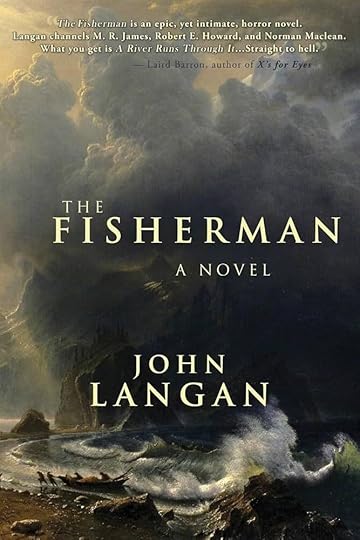Grief, Loss, and the Supernatural: Exploring the Themes of “The Fisherman” by John Langan
In “The Fisherman” by John Langan, readers are plunged into a haunting narrative that masterfully intertwines themes of grief, loss, and the supernatural.
This novel, a notable entry in supernatural horror, captivates with its rich atmosphere and complex characters, drawing readers into a world where the boundaries between reality and the supernatural blur.
As we explore “The Fisherman,” together we will see how Langan uses the eerie setting and intricate plot to build tension and suspense, inviting readers to ponder the existential questions that arise amidst the chilling events. Join me as we delve into this enthralling tale, a standout in grief and loss in literature, and discover the mysteries that unfold within its pages.
 Themes of Grief and Loss
Themes of Grief and LossIn “The Fisherman,” John Langan skillfully weaves themes of grief and loss into the fabric of the novel, creating a powerful narrative that resonates with readers. The protagonist, Abe, finds solace in fishing after the devastating loss of his wife. This activity becomes both a refuge and a source of haunting memories. Langan uses Abe’s journey to explore how grief can manifest in unexpected ways, affecting the choices and paths we take.
The supernatural elements of the story further amplify these themes, as characters confront not only personal demons but also literal ones. Langan’s portrayal of grief is nuanced, reflecting the complexities of moving forward while being tethered to the past. This exploration of grief and loss invites readers to examine their own experiences with these emotions, making the novel not just a supernatural horror story but also a poignant reflection on the human condition.
Supernatural Elements Explored“The Fisherman” delves deeply into the supernatural, blending eerie folklore with personal tragedy. The novel introduces readers to a world where the natural and the otherworldly boundaries are blurred.
Langan taps into the uncanny by introducing the mysterious Dutchman’s Creek, a place rumored to grant wishes but at a dire cost. This setting becomes a character in itself, enticing those who are burdened with grief and loss. The supernatural elements are not just for thrills but serve as a metaphor for the characters’ internal struggles. They challenge the characters to confront their deepest fears and desires.
Langan invites readers to question what lies beyond our understanding through vivid descriptions and a chilling atmosphere. This exploration of the supernatural in horror literature elevates the narrative, transforming it into a thought-provoking journey into the unknown and the consequences of venturing too far.
 Complex Characters and Relationships
Complex Characters and RelationshipsLAt the heart of the story is Abe, a man grappling with profound loss and attempting to find solace in the ordinary act of fishing. His journey is intertwined with that of Dan, a colleague who shares a similar burden of grief. Their bond, forged through shared experiences of loss, is central to the unfolding events.
Langan portrays their friendship with authenticity, highlighting how shared pain can both unite and isolate individuals. The novel explores how these complex characters navigate their relationships amidst the backdrop of supernatural horror. Each character’s depth is revealed through their interactions, choices, and the secrets they keep. Langan’s ability to delve into the intricate dynamics of human connections adds layers to the story, making it not just a tale of horror, but a profound exploration of companionship and the human psyche.
Suspenseful Atmosphere CreationThe setting—primarily the enigmatic Dutchman’s Creek—plays a crucial role in establishing this tension. Langan’s descriptions of the natural surroundings are rich and detailed, evoking a sense of foreboding that permeates the novel. The brooding landscape mirrors the internal turmoil of the characters, enhancing the eerie mood that lingers throughout the story.
Langan uses the unknown depths of the creek as a metaphor for the mysteries that lie within the human heart. The gradual unveiling of these mysteries, coupled with the characters’ descent into the supernatural, keeps readers on edge. Langan’s pacing is deliberate, allowing suspense to build slowly, drawing readers deeper into the narrative. This meticulously crafted atmosphere not only serves to captivate but also to underscore the novel’s themes, making it a standout in supernatural horror literature.
 Role of Setting in Unease
Role of Setting in UneaseThe setting of “The Fisherman” is instrumental in cultivating a sense of unease that threads through the entire novel. John Langan meticulously crafts locations that are not merely backdrops but active participants in the story. The ominous Dutchman’s Creek, with its dark, swirling waters and the legends surrounding it, serves as a constant reminder of the unknown forces at play.
This setting amplifies the characters’ internal struggles, enhancing the novel’s tension. Langan’s vivid portrayal of the natural environment envelops the reader, making the creeping dread almost tangible. The foreboding landscape becomes a reflection of the characters’ fears and unresolved grief, intensifying their psychological turmoil.
The setting also acts as a catalyst for the supernatural events that unfold, blurring the line between reality and nightmare. By leveraging the power of the setting, Langan effectively creates an atmosphere that unsettles and captivates, drawing readers deeper into his compelling narrative.
Pacing and Tension DevelopmentThe story unfolds with a measured tempo, allowing readers to fully absorb the weight of the characters’ grief and the eerie mysteries they encounter. This deliberate pacing is crucial, as it mirrors the slow unraveling of the supernatural elements at play.
Langan intersperses moments of quiet reflection with bursts of intense action, maintaining a balance that keeps readers engaged. As the plot progresses, the tension mounts steadily, driven by the characters’ deepening involvement with the supernatural. The incremental revelations and mounting stakes compel the reader to continue, eager to uncover the next piece of the puzzle.
Langan’s skillful pacing ensures that each twist and turn amplifies the suspense, creating a gripping narrative that holds the reader’s attention until the very end. This thoughtful approach to pacing not only sustains tension but also enriches the storytelling experience.



